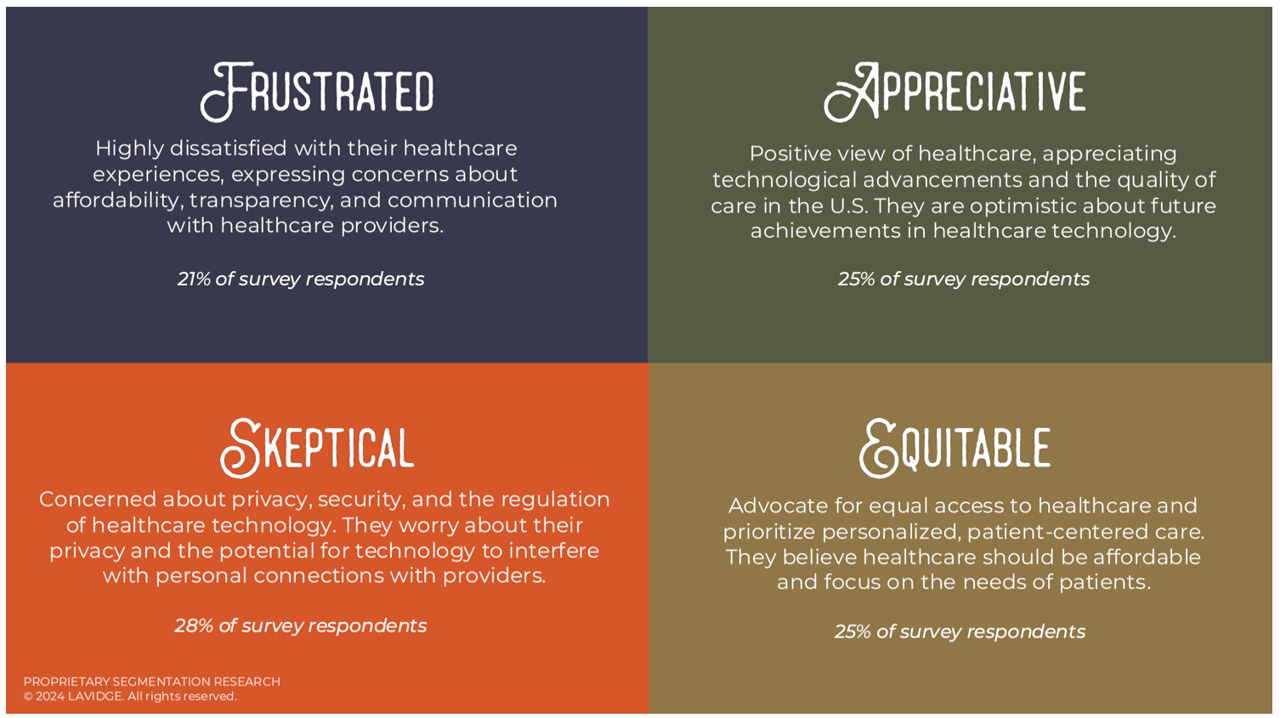Patients “yearn” for personalized services and relationships in health care — optimistic that technology can help deliver on that hope — we learn in Healthcare’s Future: Balancing Progress and Perception, a health consumer survey report from Lavidge.
Lavidge, a communications/PR/marketing consultancy, polled U.S. patients’ attitudes about health care and technology in June 2024, publishing the report earlier this month.

Start with over-arching finding that, “Three out of four patients believe the U.S. healthcare system is broken and there is a strong sense of distrust,” Lavidge asserts right at the top of the study’s press release.
The erosion in trust among U.S. health consumers is with the health care system industry segments like hospitals, insurance companies, and pharma — as patients differentiate between the “system” and the “people” working in it. American patients believe doctors and nurses are working hard to delivery care — it’s with health care institutions where trust falls apart.
Trust is also part of patients-as-health consumers’ equations when it comes to the industry’s profit motive. Team Lavidge developed a segmentation of four cohorts of patients based on peoples’ psychographics and attitudes: these are,
- The Frustrated, patients highly dissatisfied with their healthcare experiences and concerned about affordability and communication
- The Appreciative, optimistic patients with a positive view of health care appreciating technology developments and quality of care
- The Skeptical, patients worried about privacy, security, and regulation of technology; and,
- The Equitable, patients who advocate for health access and equity with patient-centered care for all people.

Note that patients falling into all four of these segments believe, in the words of Lavidge, that, “companies developing health care technology care more about making money than helping patients…All patients worry that a single medical bill could severely impact their financial security.”
And this need for financial and clinical self-care are key drivers inspiring health consumers to welcome technology’s abilities to help people manage their care, shop for care based on quality and price, and self-care at home, among other strategies to reduce costs. The bar chart illustrates various cost-reduction strategies U.S. patients have adopted to lower their medical spending, led by living healthy lifestyles, switching to generic medicines where available, using prescription drug discount apps and Rx discount cards (think: GoodRx, SingleCare), asking providers if they are in-network based on the enrollee’s health plan, and then three self-rationing tactics: delaying care, skipping care, and/or only agreeing to treatments one can afford (each self-rationing tactic garnering about 1/4th of patients’ responses).

Health Populi’s Hot Points: “Patients believe in the power of technology — as long as it benefits them,” Lavidge concludes. Consider telemedicine, the use of technology advancements for modern care protocols, and technologies that help people save money as areas where people believe in that “power” of tech for health care.
Last week, the indefatigable Sanjula Jain, Ph.D., of Trilliant Health published one of her ongoing 2024 Trends essays sharing her perspective that, “forced consumerism due to cost shifting has fostered fragmentation without corresponding value.”
This last chart comes from Sanjula’s Compass publication arraying patient-consumers’ views on health care affordability (costs) by insurance status, race/ethnicity, and income, along with Americans’ trust in health information by source. For the latter, people most-trust primary care providers, nurses, pharmacists, and friends and family, then followed by medical scientists.
As we navigate health care in America in 2025 and beyond, the importance of re-building trust in science and health care institutions will be crucial for managing costs and de-fragmenting health care delivery. The latter is a cost-increasing function, Sanjula and I agree. While technology can scale some service delivery and transparency, we should be mindful to design apps and tools and tech-enabled services with principles of ethics-by-design, privacy-by-design, and public health principles promoting access and equity. The Lavidge consumer study bolsters this mandate, further inspiring us to build trust in one another, with science, and with our health care providers.





 I am so grateful to Tom Lawry for asking me to pen the foreword for his book, Health Care Nation,
I am so grateful to Tom Lawry for asking me to pen the foreword for his book, Health Care Nation,  I love sharing perspectives on what's shaping the future of health care, and appreciate the opportunity to be collaborating once again with Duke Corporate Education and a global client on 6th May. We'll be addressing some key pillars to consider in scenario planning such as growing consumerism in health care, technology (from AI to telehealth), climate change, and trust -- the key enabler for health engagement or dis-engagement and mis-information. I'm grateful to be affiliated with the corporate education provider
I love sharing perspectives on what's shaping the future of health care, and appreciate the opportunity to be collaborating once again with Duke Corporate Education and a global client on 6th May. We'll be addressing some key pillars to consider in scenario planning such as growing consumerism in health care, technology (from AI to telehealth), climate change, and trust -- the key enabler for health engagement or dis-engagement and mis-information. I'm grateful to be affiliated with the corporate education provider  Thank you FeedSpot for
Thank you FeedSpot for